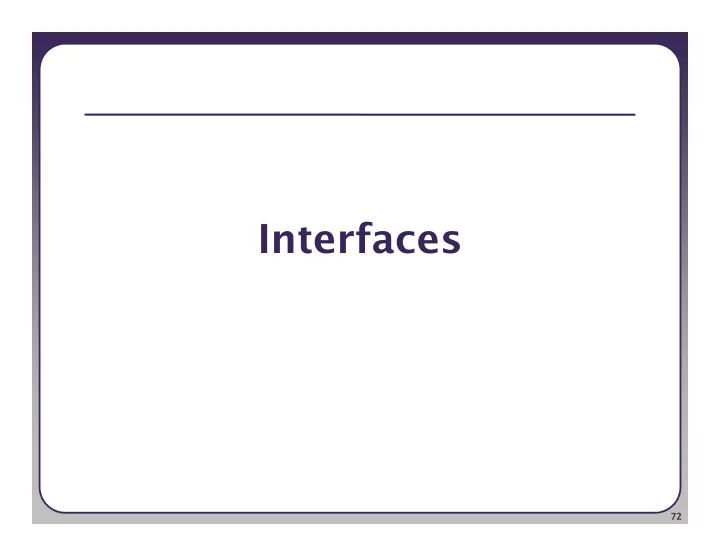

���������� 72
��������� ������ • Consider the task of writing classes to represent 2D shapes such as Circle , Rectangle , and Triangle . • Certain operations are common to all shapes: � perimeter: distance around the outside of the shape � area: amount of 2D space occupied by the shape � Every shape has these, but each computes them differently. 73
����������������������������� • Circle (as defined by radius r ): area = π r 2 r = 2 π r perimeter • Rectangle (as defined by width w and height h ): w area = w h perimeter = 2 w + 2 h h • Triangle (as defined by side lengths a , b , and c ) b area = √( s ( s - a ) ( s - b ) ( s - c )) a where s = ½ ( a + b + c ) c perimeter = a + b + c 74
��������������������� Suppose we have 3 classes Circle , Rectangle , Triangle . � Each has the methods perimeter() and area() We'd like our client code to be able to treat different kinds of shapes in the same way; e.g., � Write a method that prints any shape's area and perimeter. � Create an array to hold a mixture of the various shape objects. � Write a method that could return a rectangle, a circle, a triangle, or any other kind of shape. � Make a DrawingPanel display many shapes on screen BUT each class already subclass DrawableObject Solution = Polymorphism! But we have only 1 shot at inheritance! 75
��������������������������� Definition � A list of methods that a class promises to implement � A contract in terms of what features / methods / behavior will be implemented � Analogous to idea of roles / certifications: • "I'm certified as a CPA accountant. This assures you I know how to do taxes, audits, and consulting." • "I'm 'certified' as a Shape, because I implement the Shape interface. This assures you I know how to compute my area and perimeter." 76
��������������������������������������� � Inheritance gives you an is-a relationship and code sharing • A Lawyer can be treated as an Employee and inherits its code � Interfaces give you an is-a relationship without code sharing • A Rectangle object can be treated as a Shape but inherits no code � You extend only 1 superclass but may implement many interfaces � Interfaces only feature abstract methods • i.e. header w/o implementation • we want to allow each class to implement the behavior in its own way � Interface only feature FINAL fields 77
����������� ���� public interface name { public type name ( type name , ... , type name ); public type name ( type name , ... , type name ); ... public type name ( type name , ... , type name ); } Example public interface Vehicle { public int getSpeed(); public void setDirection(int direction); } 78
��������� ��������������� // Shape.java Describes features of all shapes public interface Shape { public double area(); public double perimeter(); } 79
��������� ����������������������� public class name implements interface { ... } Definition A class can declare that it "implements" an interface. Example public class Bicycle implements Vehicle { ... } 80
�����������������������������������!�� ���"����#������ public class Banana implements Shape { // haha, no methods! pwned } If we write a class that claims to be a Shape but doesn't implement area and perimeter methods, it will not compile. Banana.java:1: Banana is not abstract and does not override abstract method area() in Shape public class Banana implements Shape { ^ 81
�����������$���� ��������� Yes. Interfaces allow polymorphism (the same code can work with different types of objects) public static void printInfo( Shape s ) { System.out.println("The shape: " + s); System.out.println("area : " + s.area()); System.out.println("perim: " + s.perimeter()); System.out.println(); } ... Circle circ = new Circle(12.0); Triangle tri = new Triangle(5, 12, 13); printInfo( circ ); printInfo( tri ); 82
Recommend
More recommend